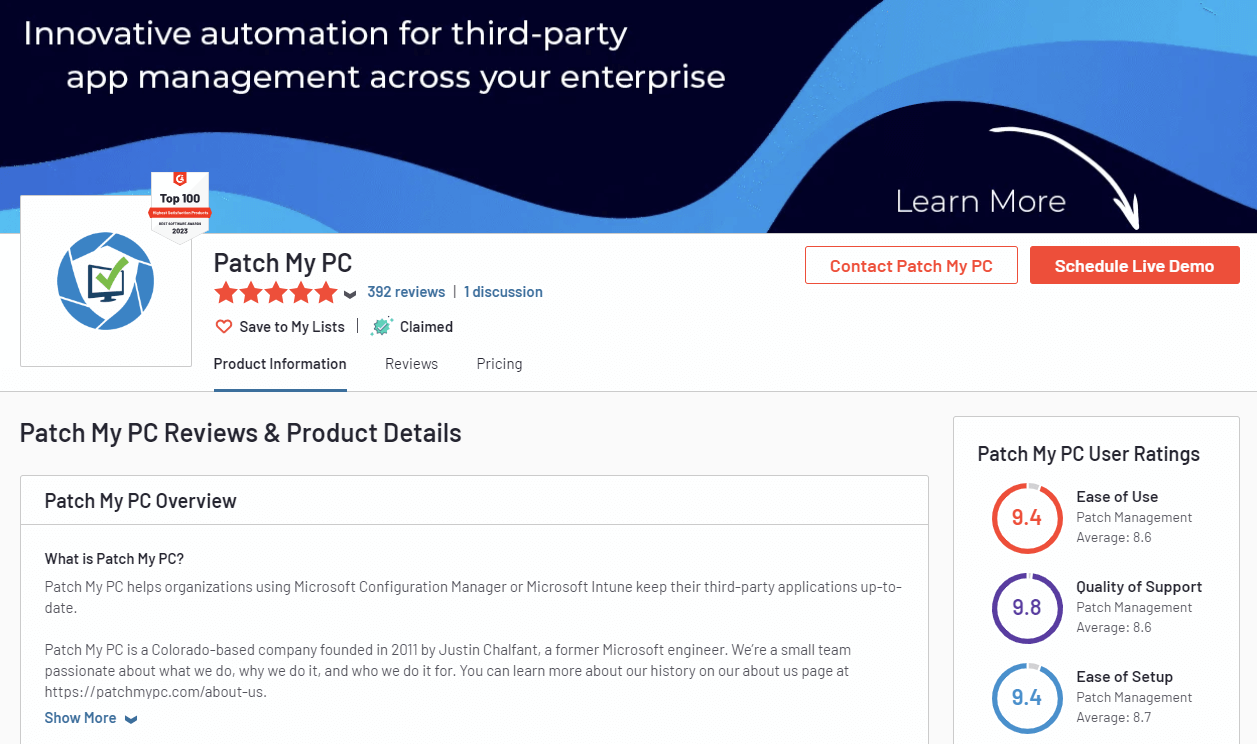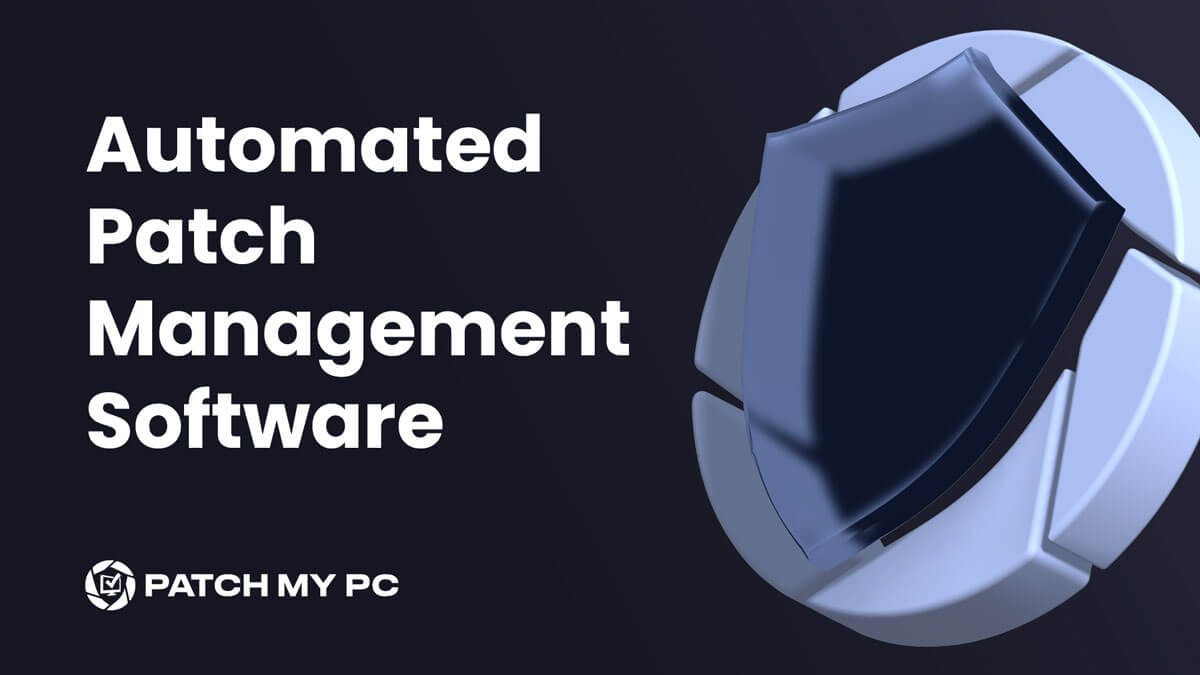
Introduction
In today’s rapidly evolving digital landscape, keeping your organization’s software up to date is a critical task. Not doing so can leave your environment exposed to vulnerabilities, security breaches, malware, and cyber threats. This is where automated patch management software comes into play. Not only does it significantly reduce the likelihood of the negative scenarios above, but it also improves and streamlines the way your IT team handles software updates.
What Is Automated Patch Management?
Automated patch management can be best described as using automation software to deploy patches, updates, and bug fixes for existing software in an organization’s environment. It’s a multistage approach that covers the entire patch management process, which includes patching, testing, deployment, and monitoring of patch releases to ensure that all systems remain secure and functional.
Automating this process requires the use of specific software designed to streamline the patch management processes. These tools are crucial for managing patches across a large number of devices efficiently and reduces the time, cost, and effort required from organizations to keep their third-party applications up to date.
What Are the Benefits?
Automating patch management brings a lot of value, making it an essential practice for any organization and its respective IT and security teams.

Enhanced Security Posture
With automated patch management software, you can swiftly fix vulnerabilities and security risks as soon as updates become available. This proactive approach significantly reduces the window of opportunity for cyber threats and ensures your organization’s data remains safe and intact. One of the most common ways computers are exploited is through vulnerabilities in outdated third-party applications or libraries. For example, in the report Top Routinely Exploited Vulnerabilities from the United States Computer Emergency Readiness Team (US-CERT), exploits are often targeted against non-Microsoft products.
Up until August 2023, Patch My PC has released a total of 5,114 third-party updates, which include 1,147 security updates that contained one or more CVE IDs. Considering each Patch My PC customer publishes fixes for over 1,530 CVEs per year, it’s clear that automated patch management goes a long way in keeping your environment safe.
Efficiency and Cost & Time Savings
Manual patching is very time-consuming and prone to human error. It takes around 3 to 5 hours to manually patch an update in-house. If you offload the tedious tasks of packaging, testing, troubleshooting, and deploying applications in your environment, your IT team will have more time to focus on other tasks that keep your environment safe and functional.
Let’s put this into perspective: the typical Patch My PC customer publishes 1,329 updates and applications per year. If packaged manually, it would take roughly 5,980 hours or 249 days to publish these same updates in your environment. By automating this process with automated patch management software, you turn months of work into minutes, saving you a lot of time, manpower, and money. If you want a quick glimpse into the Return on Investment (ROI) a third party patching solution can offer, look no further than the Patch My PC ROI Tool at https://patchmypc.com/feature-benefits-and-roi
Compliance
Automated patch management solutions usually provide reports on patch deployment and compliance status, which is important for meeting certain legal requirements and showing how secure an organization actually is. By maintaining compliance, you ensure that your organization avoids costly fines and penalties.
Minimized Downtime
Scheduling patch deployments during maintenance windows minimizes disruption to your organization’s daily operations. This ensures business continuity and overall availability, so that users can continue to work without interruptions and critical systems remain available.
Consistency
Automation ensures a consistent and standardized patching process across all endpoints, which reduces the risk of overlooking critical updates. If the process is fully dependent on humans, there is a higher potential for error.
Automated Patch Management Process
The automated patch management process typically consists of the following stages:
Patch Identification: Automated tools scan your environment and identify missing patches and updates. With these tools, you can also check the status of each endpoint and determine which patches are required.
Testing: Before deployment, you should always test patches in a controlled environment to ensure they won’t cause compatibility issues or system failures. This step is essential to prevent running into problems when patches are deployed across the entire production environment.
Deployment: After successful testing, patches are deployed across the environment. This can be done immediately or during a scheduled maintenance window, but it is important to schedule them correctly to avoid disrupting critical operations.
Monitoring and Reporting: The system monitors the status of deployed patches and provides reports on compliance and any issues encountered. This helps ensure that patches are successfully applied and that no issues occur.
Frequently Asked Questions
When people search for information on automated patch management, they often have specific questions in mind. For example:
What Is Automated Patch Management?
Automated patch management is the proactive and systematic approach to managing software updates and security patches across an organization’s network. Using patch management software strengthens overall network security.
What Are the Three Types of Patch Management?
While automated patch management is the focus here, there are also manual and semi-automatic methods available for use. Each approach has its advantages and disadvantages, but automated patch management offers the most efficient and secure solution for any environment.
What Is an Automated Patch Update Service?
This term can refer to the automated process of updating patches. An automated patch update service or tool ensures that your systems receive the latest patches and updates automatically, which reduces the risk of security vulnerabilities and improves overall network security.
What are the Benefits of Automated Patch Management?
The benefits include enhanced network security, time and money savings, compliance, minimized downtime, and consistency in the patching process.
Can I Automate Patches Across All Endpoints?
Absolutely! In this blog post, we’ve outlined how automated patch management achieves this. Whether you have a small network or a vast infrastructure with hundreds of thousands of endpoints, automation can efficiently deploy patches to all of your devices. This allows IT teams to focus on other tasks that need their full attention.
How Are Patches and Upgrades Automated?
From patch identification to deployment, automated tools and software play a crucial role in ensuring that patches and upgrades are applied as soon as they are available. What’s great about these tools is that these patches are deployed in the least intrusive way possible, this way end users can carry on with minimal interference.
What Is the Best Practice for Patch Management?
Implementing automated patch management, keeping software up to date, and regularly monitoring compliance are all essential best practices to keep your environment as secure as possible.
How Do You Implement a Patch Management System?
In this blog post, we’ve only discussed the benefits of implementing a patch management system. However, we can also provide guidance on implementing such a system. Keep reading to learn more about selecting the right software, configuring that software to meet your organization’s needs, and establishing patch management policies.
Automated Patch Management Tools
There are multiple options on the market for automated patch management tools. However, Patch My PC stands out as a top choice for its ease of use and amazing customer support (don’t take our word for it; check out our customer feedback at the end of this blog!).
Patch My PC’s Publishing Service is a very robust and complete third-party patch management software. This automated patch manager seamlessly integrates with your existing Windows management infrastructure (whether that be SCCM, Intune, or WSUS standalone) and simplifies the patch management process.
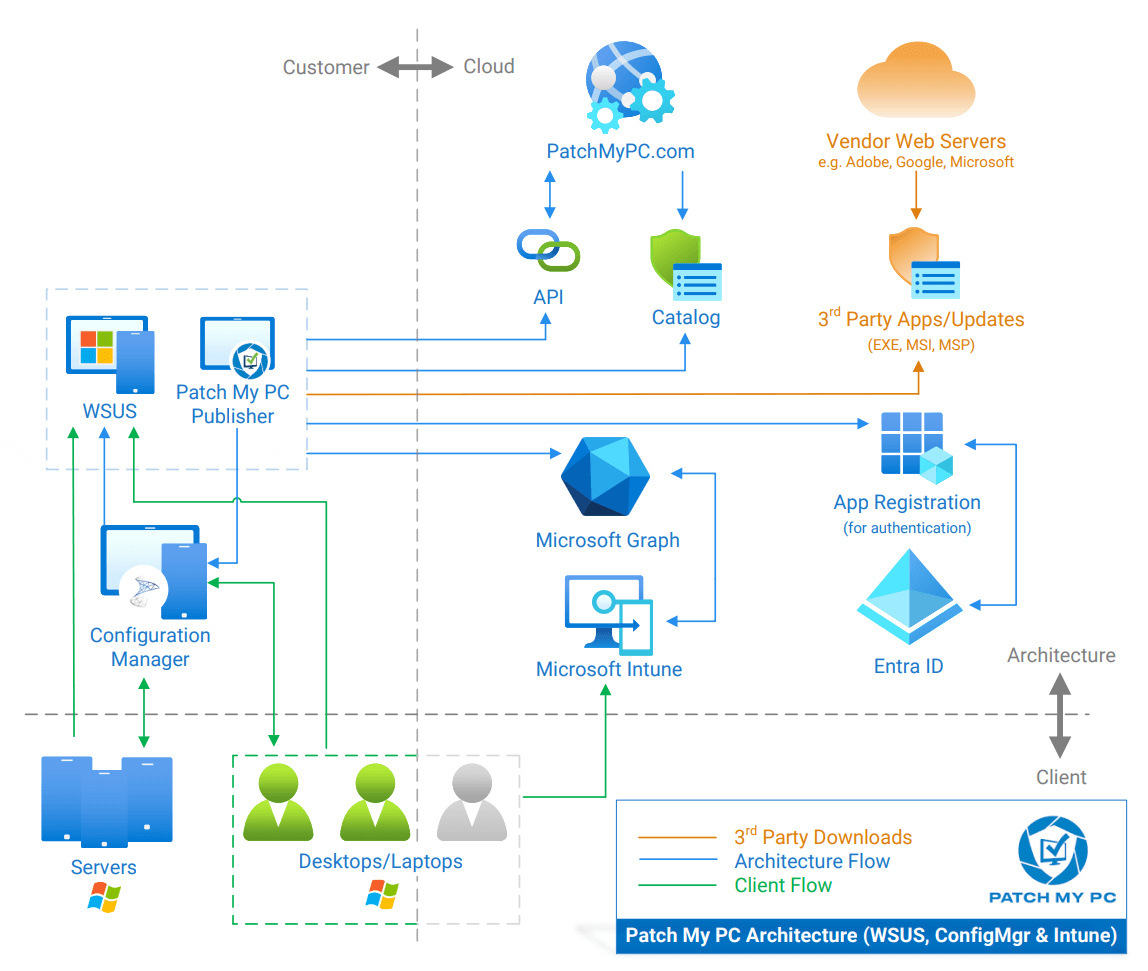
Automated patch management is no longer a luxury but a necessity in today’s cybersecurity landscape. Having a proactive approach to software updates reduces improves operational efficiency while simultaneously strengthening security. Patch My PC’s automated patch management solution empowers your organization to put security first with seamless integration, robust features, and the ability to stay one step ahead of cyber threats in a cost-effective manner.
Don’t wait for vulnerabilities to be exploited; take control of your network’s security and ensure operational excellence with automated patch management from PMPC.

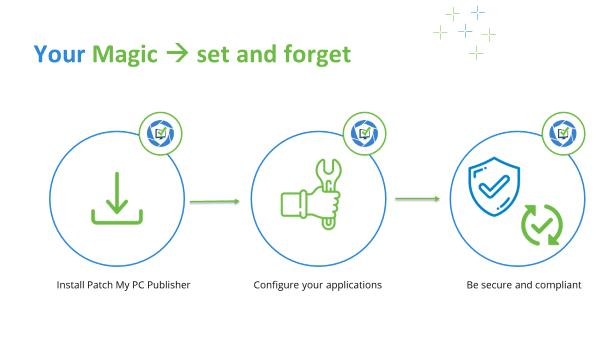
Why Should You Trust Us?
We will let our current customers answer that one for you! Below are some of the reviews we received from independent websites such as Gartner and G2:
Customer Reviews: See What Our Customers Think | Patch My PC
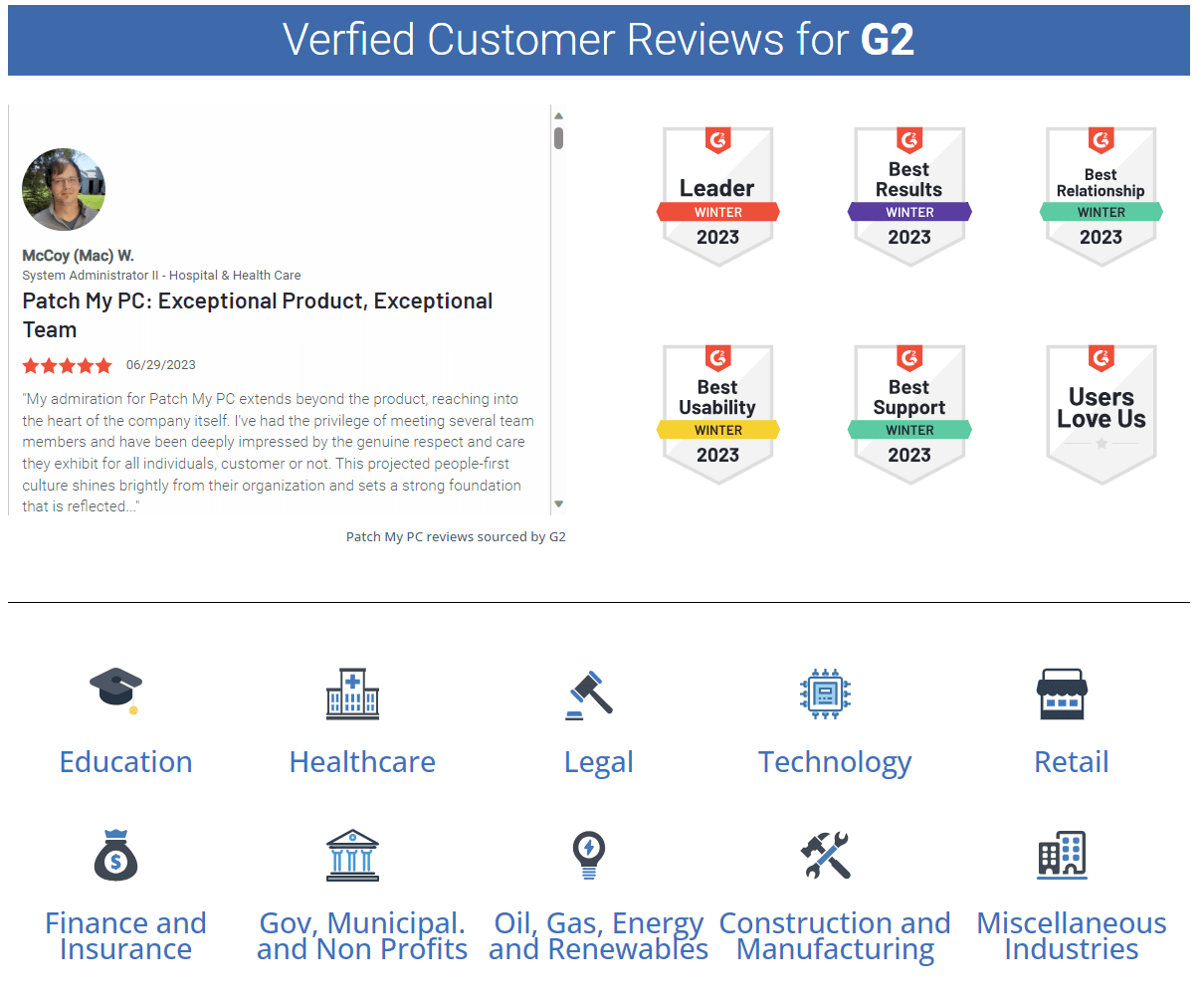
Patch My PC Patch Management Reviews, Ratings & Features 2023 | Gartner Peer Insights
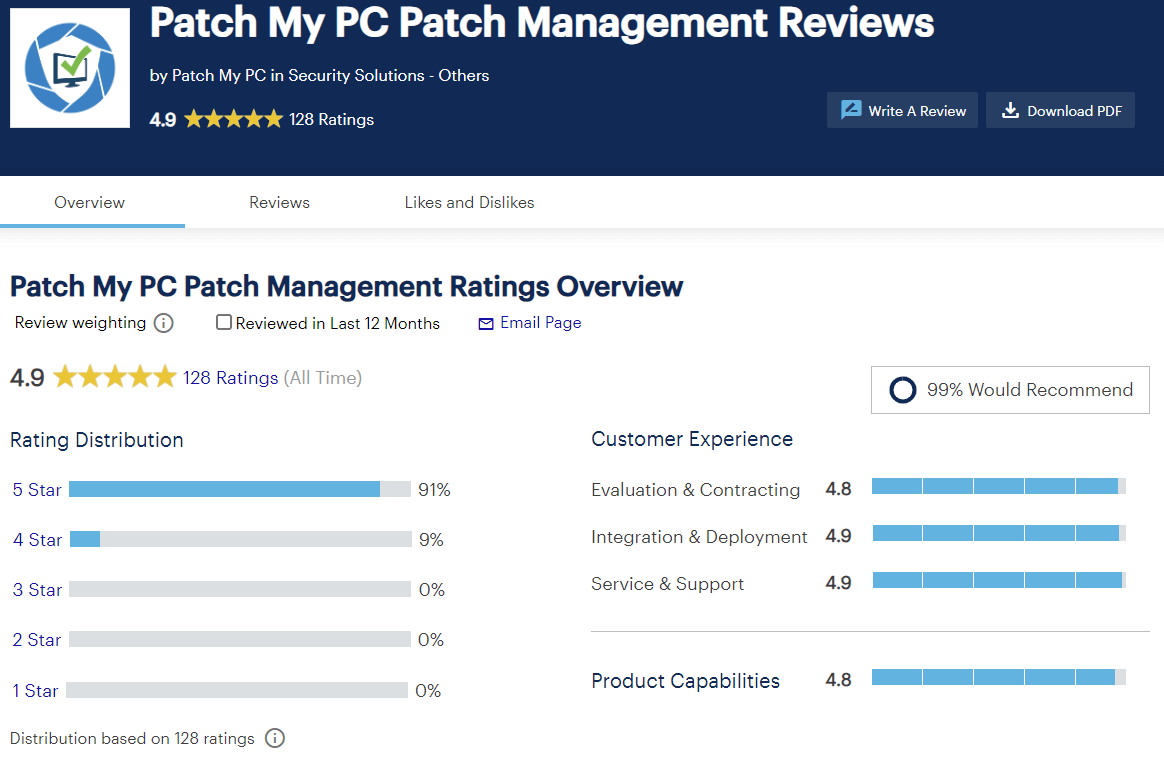
Patch My PC Reviews 2023: Details, Pricing, & Features | G2
